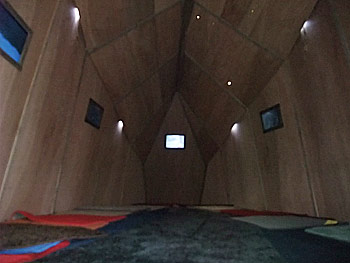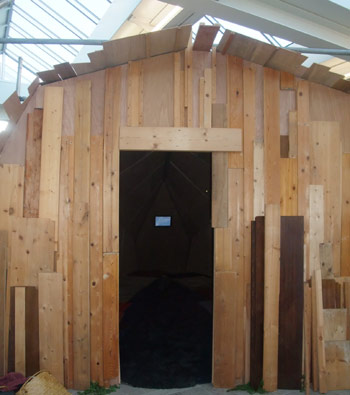![]() Other work by Sen + Sonja Kāinga a roto DVD + video info Kainga in 2011 Sonja's c.v.
Other work by Sen + Sonja Kāinga a roto DVD + video info Kainga in 2011 Sonja's c.v.
View a 5 min video of this installation

Side view of Kāinga a roto (Home within),
in the UNwanted Land parcous.
To a version of my text in the catalogue >>
I was born in 1960, to a Scottish-Irish New Zealand mother and Dutch father, on a farm in the shadow of Mount Taranaki near the Mangawero river in the central north island province of Taranaki, in New Zealand/Aotearoa.
A Māori person introduces herself by reference to the mountain and the river of their birth or their tribe, not only as a form of identification but to acknowledge the relevance of the natural world in one's cultural world.
The 'unwanted land' of my childhood has always been an intrinsic part of my identity, an identity later shaped through a succession of re-locations. This installation of five videos inside a 'house-canoe' is my first attempt at using some incidents from my childhood in an artform. Because the abuses of my childhood were dramatic, I've tended to avoid addressing them, afraid they would overshadow the 'wanted land.'
In the Unwanted Land exhibition, my canoe-home, positioned underneath the mountain range of the scaffolding, is a space for inner or metaphysical movement.

Detail showing a still from the 17 minute video,
The Tears of Rangi
Ehara taku kāinga i te kāinga tu tonu.
He kāinga nekeneke.
My home is not a home that stands still.
It is a home that moves.
This phrase references the Maori proverb: "Ehara taku maunga i te maunga nekeneke. He maunga tu tonu."
My mountain is not a mountain that moves around. It is a mountain that stands still.
Here I'm saying that my identity, 'my home' is on the move - is not in one particular place.




A still from The Two Lands, showing a flag filmed at Parihaka
superimposed on footage of Mount Taranaki.
Parihaka is the site of a Peace festival.
See: www.parihaka.com
It is where Te Whiti o Rongomai, Tohu Kākahi and others led a
movement in the 1860s using passive resistance to land seizures
and where British soldiers committed some of the worst attrocities
in the New Zealand Land Wars.
I was raised on a farm close to this mountain.
In my video this flag appears at a part of the narrative
where I discuss trust and mistrust in relation to my own background
and my family.
On entering, above are the constellations of Orion and Matariki (The Seven Sisters / Pleiades) as seen in June in Aotearoa at the time of the Maori New Year. Matiriki means "eyes of God" or or "little eyes."
Below these, the videos function like windows onto the land we inhabit. In particular they show the diverse beauty of New Zealand rivers, forests, beaches and farmlands.
The carpet landscape underfoot feels like the mossy ground in a New Zealand forest.
This suite of videos also weaves between various worlds - the world of Tāne (the forest and the land), the world of Tāwhirimatea (the winds) represented by sounds of breathing and signs of the wind (such as in the flags filmed at the Parihaka Peace Festival), patterns on the surface of water, and a storm.
In "The Moving Heart", the world of Rangi (the heavens) is referred to through Toroa Pohatu's lyrics about the celestial inspiring and providing illumination.
In the Māori language, Whānau Mārama means both family of the stars and family which inspires.

Still from Moving Heart

The imagery of gliding albatross, manaia (bird-human figures) and taniwha (water-spirits) and Sonja's koru-filled sculpture harmonise with this gliding between realms: the familial and the celestial.

Still from The Dark Valley
A similar switching between the personal and the external occurs in "The Dark Valley" in the use of text, while in "The Two Lands" the timing and visuals is what gives distance to a personal narrative.

Left to Right:
Heart of the Land, The Two Lands, The Moving Heart

Still from the DVD version of The Two Lands
Birds can be heard in all of the videos in the installation, beings which live on the land, in the air and on the water.
In "The dark Valley" the rooster strutting on the beach seems out of place, an import, while in "The Tears of Rangi" the Pukeko (native hen) steps with care, and in "The two lands" crows scatter outwards.

Still of a Pukeko on the Otago Peninsula
from the video The Tears of Rangi
Birds are heard sometimes as part of the natural world and at other times as part of a soundscape.

Still from The Two Lands

Still from The Tears of Rangi
However the world which dominates in all the videos is that of Tangaroa (the seas and rivers). Because water doesn't stand still, we are carried along, by the flow, the sounds, and by a narrative that is sometimes personal and traumatic - at other times juxtaposed against theoretical text.



There multiple viewpoints (windows or eye-holes) not only to reflect the subjectivity of memory in relation to childhood, my own mixed background as a foreigner living in the Netherlands (I moved here at the age of 29), as an artist who was raised in a working-class background, and as a mother myself, but also so viewers must choose a viewpoint. Each of the videos provides a differing perspective at any moment. All the videos have different lengths and loop seamlessly, so that the viewer can never step into the same experience twice.
In the spaces between the videos, are suspended piupiu (Parts from a flax skirt. A gift from a kapa haka group via Jerome Kavanagh / Ngā iwi o Ngāti Hinemanu/Ngāti Paki).
These 'hangings' serve as points for reflection, like breathing spaces between the stories in the videos.


These 'relocated' hangings refer to tukutuku panels in a wharenui
(Māori ancestoral/meeting house).
These are fibre panels traditionally made by women, and are placed alternately between the carved panels or posts, traditionally made by men.
Above, the wooden beams in this Kāinga (Home) symbollize the spine and ribs of the ancestor just as they do in a Māori wharenui. And of course there's the reference to the story of Jonah and the whale, where visitors are inside, hearing stories from the inside (the child's world).


Detail of inside a wharenui, a Māori ancestoral
or meeting house showing
the kowhaiwhai (paintings on the ceiling)


There are more similarities to a wharenui, as you can see above. Instead of a carved tekoteko (symbollically the head of the ancestor) I've placed a piece of old wood. Tane the guardian of the forests and humans, is often symbollized by a tree. We chose to use wood fashioned and discarded by others - collected by Sonja in the 'forests' of Dutch cities for the front of this Kāinga (Home).

The seats and furniture made by Leiden artist, Frida van der Poel, are not only there so people can take off their shoes more easily, but also can be a place for socializing while still outside the 'home within.'
We chose a used and sanded wooden panel for the pare above the doorway, which would traditionally be carved with images relating to birth. We chose not to use any carving or painting in this 'home', so that the wood shows directly its own history - that it was cut and sanded, before it was collected and then placed here.
As you pass under the pare and step onto the carpet you pass from one world to another, and have made a preparation for this 'migration' by removing your shoes.


The videos in this installation are:
1. Ngā Roimata o Rangi
The tears of Rangi
(first on the left as you enter)
17 min. 2 sec.
2. The Moving Heart
Te Ngākau Nekeneke
(first on the right as you enter)
installation version: 13 minutes
3. The Two Lands,
(next to video nr. 2)
16 minutes. The video alternates with and without the spoken text.
4. The Dark Valley
(next to video nr. 1)
16 minutes. 14 min. 10 sec.
5. Heart of the Land
Te Ngakau o te whenua
(located at the end)
Installation version, 14 min. 12 sec.
Piano music by Tama McGlinn lasts 4 minutes, then the call of the grey kiwi is at about 10 minutes.

Placed inside part of the scaffolding beside Kāinga a roto is the sculpture Tablets by Sonja which consists of two illuminated cast resin blocks of text.
The texts, each the thoughts of an individual, one a man and one a woman, come from a short story by New Zealand novelist, Katherine Mansfield.
See this page for more
about Tablets | Tafelen.
More photos of the interior
To the 2011 Istanbul version
To the 2013 New Plymouth version